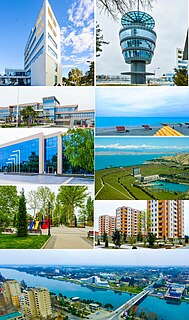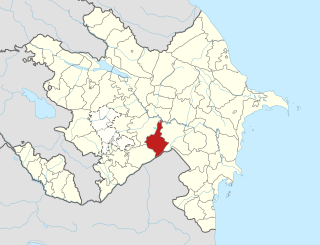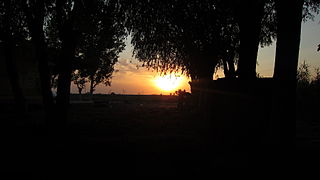Related Research Articles

Mingachevir is the fourth-largest city in Azerbaijan with a population of about 106,000. It's often called the "city of lights" because of its hydroelectric power station on the Kur River, which divides the city down the middle.

Neftchala District is one of the 66 districts of Azerbaijan. It is located in the south-east of the country and belongs to the Shirvan-Salyan Economic Region. The district borders the districts of Jalilabad, Bilasuvar, Salyan, Lankaran, and Masally. Its capital and largest city is Neftchala. As of 2020, the district had a population of 88,900.

Beylagan District is one of the 66 districts of Azerbaijan. It is located in the centre of the country and belongs to the Central Aran Economic Region. The district borders the districts of Fuzuli, Aghjabadi, Zardab, Imishli, and the Ardabil Province of Iran. Its capital and largest city is Beylagan. As of 2020, the district had a population of 99,500.

Goychay District is one of the 66 districts of Azerbaijan. It is located in the centre of the country and belongs to the Central Aran Economic Region. The district borders the districts of Agdash, Qabala, Ismayilli, Kurdamir, and Ujar. Its capital and largest city is Goychay. As of 2020, the district had a population of 121,700. It is famous for its pomegranate growing industry, and for its pomegranate festival.

Hajigabul District is one of the 66 districts of Azerbaijan. It is located in the east of the country and belongs to the Shirvan-Salyan Economic Region. The district borders the districts of Kurdamir, Agsu, Shamakhi, Gobustan, Absheron, Baku, Salyan, Sabirabad and the city of Shirvan. Its capital and largest city is Hajigabul. As of 2020, the district had a population of 76,600.

Imishli District is one of the 66 districts of Azerbaijan. It is located in the centre of the country and belongs to the Central Aran Economic Region. The district borders the districts of Beylagan, Zardab, Kurdamir, Sabirabad, Saatly, Bilasuvar, and the Ardabil Province of Iran. Its capital and largest city is Imishli. As of 2020, the district had a population of 131,400.

Kurdamir is a city and the capital of the Kurdamir District of Azerbaijan. It is located in Aran Economic Region.

Orography of Azerbaijan refers to the rocky, mountainous and elevated terrains in Azerbaijan. The tectonic structure is typical for the orography of the country. The main morphostructural units are the Greater Caucasus, the Lesser Caucasus, the Gusar plane, the Samur-Devechi lowland, the Kur intermountain trough, the Karabagh volcanic highland, the near and middle Araz Ridges and Talysh Mountains.

The climate of Azerbaijan is very diverse. Nine out of eleven existing climate zones are present in Azerbaijan.

The water bodies of Azerbaijan were formed over a long geological timeframe and changed significantly throughout that period. This is particularly evidenced by remnants of ancient rivers found throughout the country. The country's water systems are continually changing under the influence of natural forces and human introduced industrial activities. Artificial rivers (canals) and ponds are a part of Azerbaijan's water systems.
Ag-Gel National Park — is a national park of Azerbaijan. It was established in an area in Ağcabədi Rayon and Beyləqan Rayon administrative districts on July 5, 2003, on the basis of the former "Ag-Gol State Reserve" and "Ag-Gol State Game Reserve" which it superseded, on a surface area of 17,924 hectares (179.24 km2).
Sarysu is the largest lake of Azerbaijan located in Imishli and Sabirabad raions of the Kur-Araz Lowland.
Hajikabul is the sixth largest lake of Azerbaijan.

The climate of Hungary, is characterized by its position. Hungary is in the eastern part of Central Europe, roughly equidistant from the Equator and the North Pole, more than 1,000 kilometres (600 mi) from either and about 1,000 kilometres from the Atlantic Ocean.
Lake Ağgöl is a large salty lake in the Kur-Araz Lowland, specifically the Aghjabadi and Imishli rayons of Azerbaijan. It is the second-largest of about 450 lakes in the country. Ağgöl is considered an important habitat in Azerbaijan and the Caucasus. Located in the Ağgöl National Park, it is a part of the wetland system, which is an important location for migrating birds, especially for globally endangered species stopping-over and breeding at the lake.
Potential of using of climatic resources, including solar and wind energy is large in Azerbaijan, despite that the share of these resources within energy production is still small.
The Azerbaijan is a country with very favorable natural conditions and rich natural resources. Snowy peaks, high mountains, foothill fertile soils, wide plains, Lowest Land Points Below Ocean Level are the main landscape forms of republic. This complex landscape structure has caused the variety in natural conditions - climate, soil-vegetation, and water resources. This, in turn, led to the uneven distribution of population and farms on the territory, and the specialization of production on different types.

The Yana-Indigirka Lowland is a large, low alluvial plain located in northern Siberia, Far Eastern Federal District, Russia.

The Central Yakutian Lowland or Central Yakutian Lowlands, also known as Central Yakut Plain or Vilyuy Lowland, is a low alluvial plain in Siberia, Russia.
References
This article may be expanded with text translated from the corresponding article in Azerbaijani. (July 2020)Click [show] for important translation instructions.
|